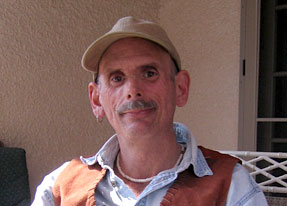Meet Jon

Jon grew up in Cincinnati, Ohio, and began his career there after graduating from Christ Hospital School of Nursing. He was working at a nursing facility in suburban Minneapolis when he first learned he was HIV-positive. Now in his fifties, Jon is an example of the hopeful trend he describes; he has been living with HIV/AIDS for over 20 years.
Since the mid-1980s, he notes, possibilities for treating and managing the disease have increased dramatically. “I was diagnosed back in 1986 with HIV. Back then the only medication they had was AZT, and that had a lot of side effects. It made me so ill I stopped taking it. Then in 1993 I was diagnosed with full-blown AIDS because my T-cell count went below 200. That’s when I became disabled, more or less. In 1993 the new protease inhibitors came out, so I started taking those. I’m on a good regimen of drugs right now that’s keeping me well.”
Jon first came to Clare Housing in 1998, after a period of severe sickness. He was one of the first four residents of the newly opened Grace House II. He was able to move into his own apartment in Loring Park, enjoying five years of relative health before illness returned. After a year-long stay in a nursing home, he moved into Agape Dos, where he now resides.
When asked his opinion on living at Agape Dos, Jon is quick to reply, “I love it here. I really like it, it’s very homey.” He enjoys the privacy of having his own room, and also the community of a shared kitchen and living room. Mainly, though, he is glad for the sense of security: “It’s a feeling of being safe, you know. It’s a safe place. I feel like I’m doing what I’m supposed to be doing while I’m here, even though caregivers are not watching over me every minute. We’re pretty independent. If we do need help, the caregivers on duty are here to help us, like with our laundry, or cooking meals or whatever. But we take so many medications; basically it’s nice to have the staff set up my meds and then distribute them to me at the right times of the day. That helps, because when you live by yourself it’s easy to forget.”
Having assistance with his many medications allows Jon more time to do what he loves; in addition to taking long walks, reading Mary Higgins Clark mysteries, and watching classic sitcoms, staying connected with family and friends is at the top of his list. “During the nice summer days I get out a lot. I go out with my sister and her husband for dinner; sometimes I go out to their place on the weekends and stay, so I can see my niece and nephews. I have a friend who lives just down the street, and a friend who lives in Eden Prairie, and we like to get together.”
Pausing to reflect, he adds, “I’ve had my ups and downs but right now I’m doing really well; my blood work and everything is coming back good. And I’m feeling good.”
Jon’s story serves as a great example of the ups and downs people may experience when living with HIV for many years. Clare Housing’s variety of housing and care options are designed to be flexible and responsive to the changing needs of our residents, like Jon.

